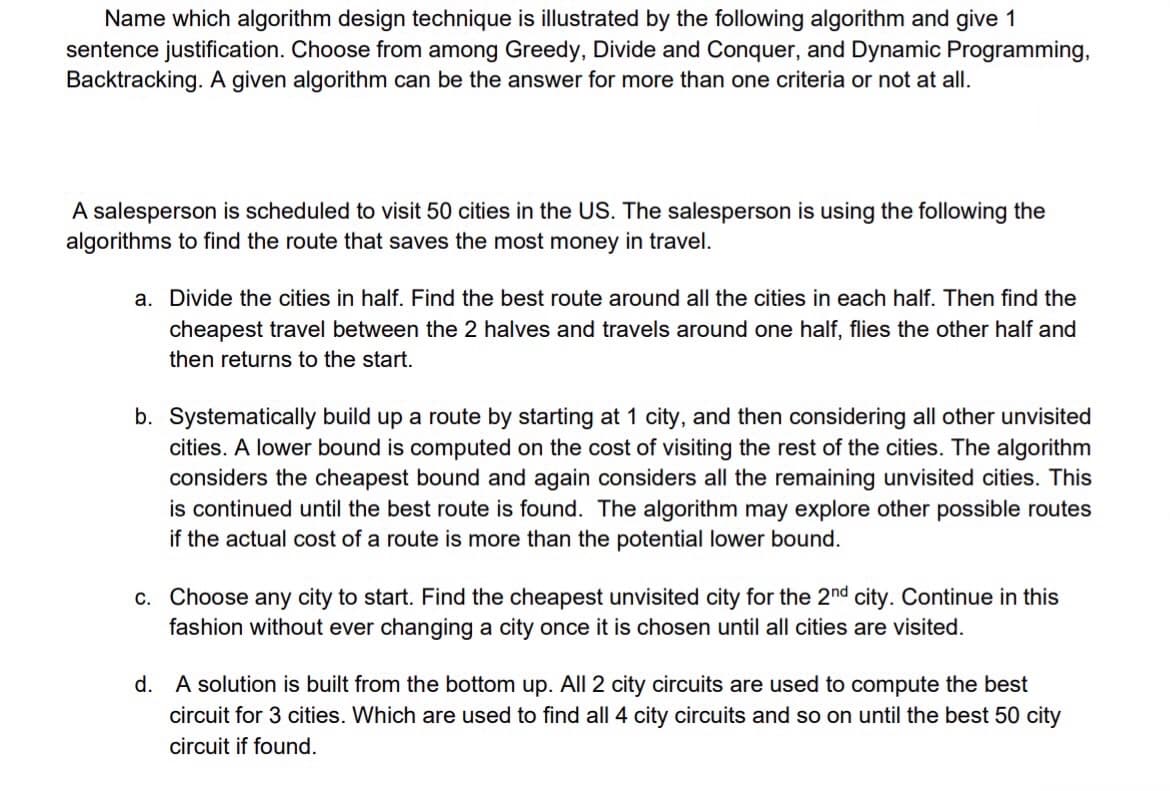Name which algorithm design technique is illustrated by the following algorithm and give 1 sentence justification. Choose from among Greedy, Divide and Conquer, and Dynamic Programming, Backtracking. A given algorithm can be the answer for more than one criteria or not at all. A salesperson is scheduled to visit 50 cities in the US. The salesperson is using the following the algorithms to find the route that saves the most money in travel. a. Divide the cities in half. Find the best route around all the cities in each half. Then find the cheapest travel between the 2 halves and travels around one half, flies the other half and then returns to the start. b. Systematically build up a route by starting at 1 city, and then considering all other unvisited cities. A lower bound is computed on the cost of visiting the rest of the cities. The algorithm considers the cheapest bound and again considers all the remaining unvisited cities. This is continued until the best route is found. The algorithm may explore other possible routes if the actual cost of a route is more than the potential lower bound. c. Choose any city to start. Find the cheapest unvisited city for the 2nd city. Continue in this fashion without ever changing a city once it is chosen until all cities are visited. d. A solution is built from the bottom up. All 2 city circuits are used to compute the best circuit for 3 cities. Which are used to find all 4 city circuits and so on until the best 50 city circuit if found.
Name which algorithm design technique is illustrated by the following algorithm and give 1 sentence justification. Choose from among Greedy, Divide and Conquer, and Dynamic Programming, Backtracking. A given algorithm can be the answer for more than one criteria or not at all. A salesperson is scheduled to visit 50 cities in the US. The salesperson is using the following the algorithms to find the route that saves the most money in travel. a. Divide the cities in half. Find the best route around all the cities in each half. Then find the cheapest travel between the 2 halves and travels around one half, flies the other half and then returns to the start. b. Systematically build up a route by starting at 1 city, and then considering all other unvisited cities. A lower bound is computed on the cost of visiting the rest of the cities. The algorithm considers the cheapest bound and again considers all the remaining unvisited cities. This is continued until the best route is found. The algorithm may explore other possible routes if the actual cost of a route is more than the potential lower bound. c. Choose any city to start. Find the cheapest unvisited city for the 2nd city. Continue in this fashion without ever changing a city once it is chosen until all cities are visited. d. A solution is built from the bottom up. All 2 city circuits are used to compute the best circuit for 3 cities. Which are used to find all 4 city circuits and so on until the best 50 city circuit if found.
Related questions
Question

Transcribed Image Text:Name which algorithm design technique is illustrated by the following algorithm and give 1
sentence justification. Choose from among Greedy, Divide and Conquer, and Dynamic Programming,
Backtracking. A given algorithm can be the answer for more than one criteria or not at all.
A salesperson is scheduled to visit 50 cities in the US. The salesperson is using the following the
algorithms to find the route that saves the most money in travel.
a. Divide the cities in half. Find the best route around all the cities in each half. Then find the
cheapest travel between the 2 halves and travels around one half, flies the other half and
then returns to the start.
b. Systematically build up a route by starting at 1 city, and then considering all other unvisited
cities. A lower bound is computed on the cost of visiting the rest of the cities. The algorithm
considers the cheapest bound and again considers all the remaining unvisited cities. This
is continued until the best route is found. The algorithm may explore other possible routes
if the actual cost of a route is more than the potential lower bound.
c. Choose any city to start. Find the cheapest unvisited city for the 2nd city. Continue in this
fashion without ever changing a city once it is chosen until all cities are visited.
d. A solution is built from the bottom up. All 2 city circuits are used to compute the best
circuit for 3 cities. Which are used to find all 4 city circuits and so on until the best 50 city
circuit if found.
Expert Solution
This question has been solved!
Explore an expertly crafted, step-by-step solution for a thorough understanding of key concepts.
Step by step
Solved in 2 steps
